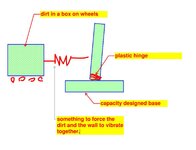In our region (Puget Sound WA), it seems like Geotechs keep increasing their seismic surcharge recommendations.
In the days prior to it being a code requirment, the few Geotechs ahead of the curve were commonly recommending about 8H (in psf)
Once it became codified, the design recommendations settled in around 8 to 12H for quite a while
In recent years, those values have crept up to as high as 15H, 18H, and even 25H!!
Whenever we try asking about it, we usually hear something like, ground motion maps have gone up. Yes but 2 to 3x???
Starting to wonder if what we're seeing is a wider and wider disconnect between Geotechnical and Structural considerations.
At those levels, the structural design of the retaining wall is severely affected so it's worth taking a closer look.
For example:
Building structures are not required to be designed for peak ground accelerations.
Instead we use a force reduction (or R value) for design and rely on good detailing to dissipate the excess energy.
Wouldn't it be consistent to apply that concept to reduce the seismic pressures resisted by the retaining structure?
In the days prior to it being a code requirment, the few Geotechs ahead of the curve were commonly recommending about 8H (in psf)
Once it became codified, the design recommendations settled in around 8 to 12H for quite a while
In recent years, those values have crept up to as high as 15H, 18H, and even 25H!!
Whenever we try asking about it, we usually hear something like, ground motion maps have gone up. Yes but 2 to 3x???
Starting to wonder if what we're seeing is a wider and wider disconnect between Geotechnical and Structural considerations.
At those levels, the structural design of the retaining wall is severely affected so it's worth taking a closer look.
For example:
Building structures are not required to be designed for peak ground accelerations.
Instead we use a force reduction (or R value) for design and rely on good detailing to dissipate the excess energy.
Wouldn't it be consistent to apply that concept to reduce the seismic pressures resisted by the retaining structure?

